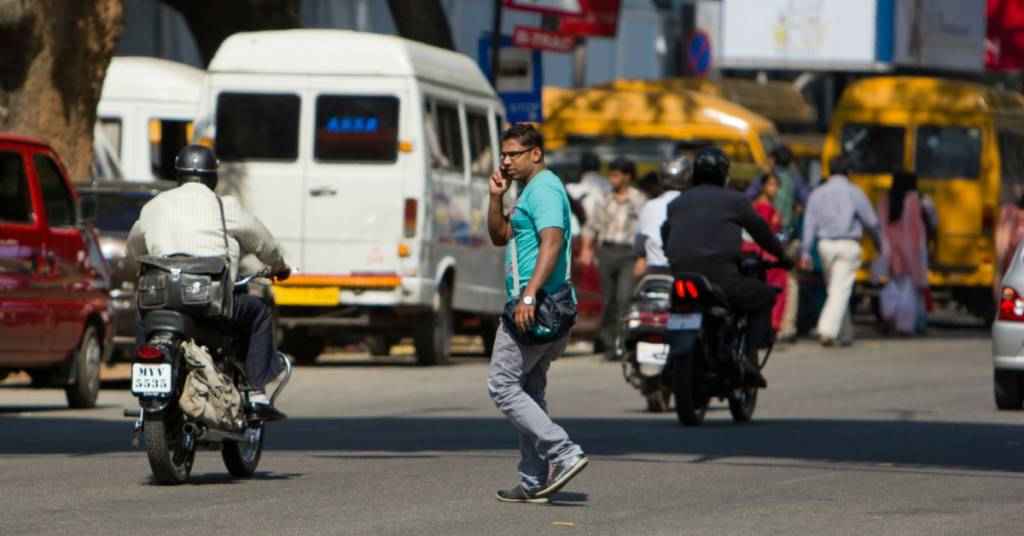One of the major cause of increasing road accidents is the inattentiveness of pedestrians. Most crashes occur when the pedestrian crosses the street and many seem to result from the pedestrian’s inattentiveness. Thus, when pedestrians are using mobile phones, distracted attention may increase their risk of accidents. We find a lot of people text messaging, on the phone, looking down or listening to music. Pedestrians have completely taken the liberty to walk freely on the roads ignoring the very fact that they can be hit by vehicle due to their such easy-going attitude. Most of the times, the pedestrian takes the risk of crossing the road despite knowing the fact that the vehicle is approaching. Their mentality has become such that they expect the vehicle to stop and also blame the driver if in case they get hurt or the if vehicle the passes closely.
Pedestrians have exceptional skills in multi-tasking. From listening to music, attending a call, eating on the run, having a conversation, texting to what not; they will not mind doing these things while crossing the roads. When pedestrians choose to walk down a street with a high level of motor vehicle traffic, they are automatically putting themselves at greater risk for an accident.
The capacity to respond to pedestrian safety is an important component of efforts to prevent road traffic injuries. To tackle such careless attitude and ignorance on part of the pedestrians, infrastructure for pedestrians in a prerequisite.
One of the biggest problems with the majority of Indian cities is that there is no pedestrian infrastructure. As of today, more than 50 per cent of the global population lives in cities and the same will be true for India very soon. As per various surveys, less than 30 per cent of Indian roads have footpaths. Since the Atal Bihari Vajpayee government came to power, India has been on a highway building spree to connect the various cities and parts of the country. Although, the intracity connectivity remains poor. Everyone who visited Mumbai is aware of the plight of Mumbaikars in travelling one place to another. Indian roads are simply not meant for walking.
The colonial administrators of India exploited India to fill their pockets. The post-colonial literature of the country has often criticized colonial administrators and has done it for the right reasons. When the British first came to India, the country accounted for one-fifth of the global GDP and when the colonial masters left, the ‘crown jewel of British Empire’ was reduced to among poorest countries of the world. But, the British did many things right. For example, the urban design of colonial cities of the country remains far better than our modern-day cities. Mumbai is the best example of this.
South Mumbai (the colonial part of the city) has one of the finest urban infrastructures in any city of the country. There exist an adequate drainage system, pedestrian infrastructure- pavements, shades, and signage, a well-functioning power supply system and many other things the city has got right. On the contrary, North Mumbai, which developed in the post-colonial era, does not have the proper urban infrastructure. The drainage system is poor, there is no pedestrian infrastructure, and footpaths are often used by hawkers.
There is a need to build infrastructure for intracity connectivity and walkability and the pedestrian infrastructure should be the focus. If the same roads are being used for travelling through the vehicle as well as for walking, it will create traffic problems and is unsafe for the commuters. This has been proven in many of the cities.
Every year, thousands of people die or get injured due to lack of pedestrian infrastructure. The reason behind this is lack of footpaths, underpasses, overpasses, and properly signed roads. Majority of intracity connectivity roads lack footpaths and, even if there are footpaths, they are either used by street hawkers or by vehicle owners for parking. There is no space for walking.
In the majority of the cities, people use the same roads used by vehicles. Pedestrians also tend to avoid using the foot-over bridges considering the fact that it will take more time to climb the stairs and then reach the other side of the road, this, in turn, disrupts the traffic and often leads to accidents. Even while the government has provided zebra crossing, foot-over bridges and other amenities for the pedestrians, the pedestrians still chose to opt for other ways disregarding the amenities.
Jaywalkers, as they are known are the pedestrians who walk in or cross a roadway that has traffic, other than at a suitable crossing point, or otherwise in disregard of traffic rules. Pedestrians like these are found in every nook and corner in India. They tend to climb the dividers to cross the roads and thus risk their lives.
Just like a Motor Vehicle Act, a ‘Pedestrian Act’ is the need of the hour in order to set rules and penalties for the pedestrians who are in the misconception- It’s my way or highway. Such pedestrians could be easily punished owing to a proper Pedestrian Act. As a result, there will a drop in the number of accidents.
The Indian traffic system operates on the principle of ‘social justice’ rather than ‘rule of law’. It has been observed that if a vehicle hits a pedestrian, the pedestrian without a second thought blames the driver, on the contrary, the carefree attitude of the pedestrian is the reason behind such incidents.
It’s high time that the government comes with a Pedestrian Act and takes strict measures to implement it. It’s a great step for the motor vehicle users as well as for the safety of pedestrians. Pedestrians need to change their ignorant attitude and should utilize existing conveniences. Government intervention is also necessary to encourage pedestrian infrastructure.
